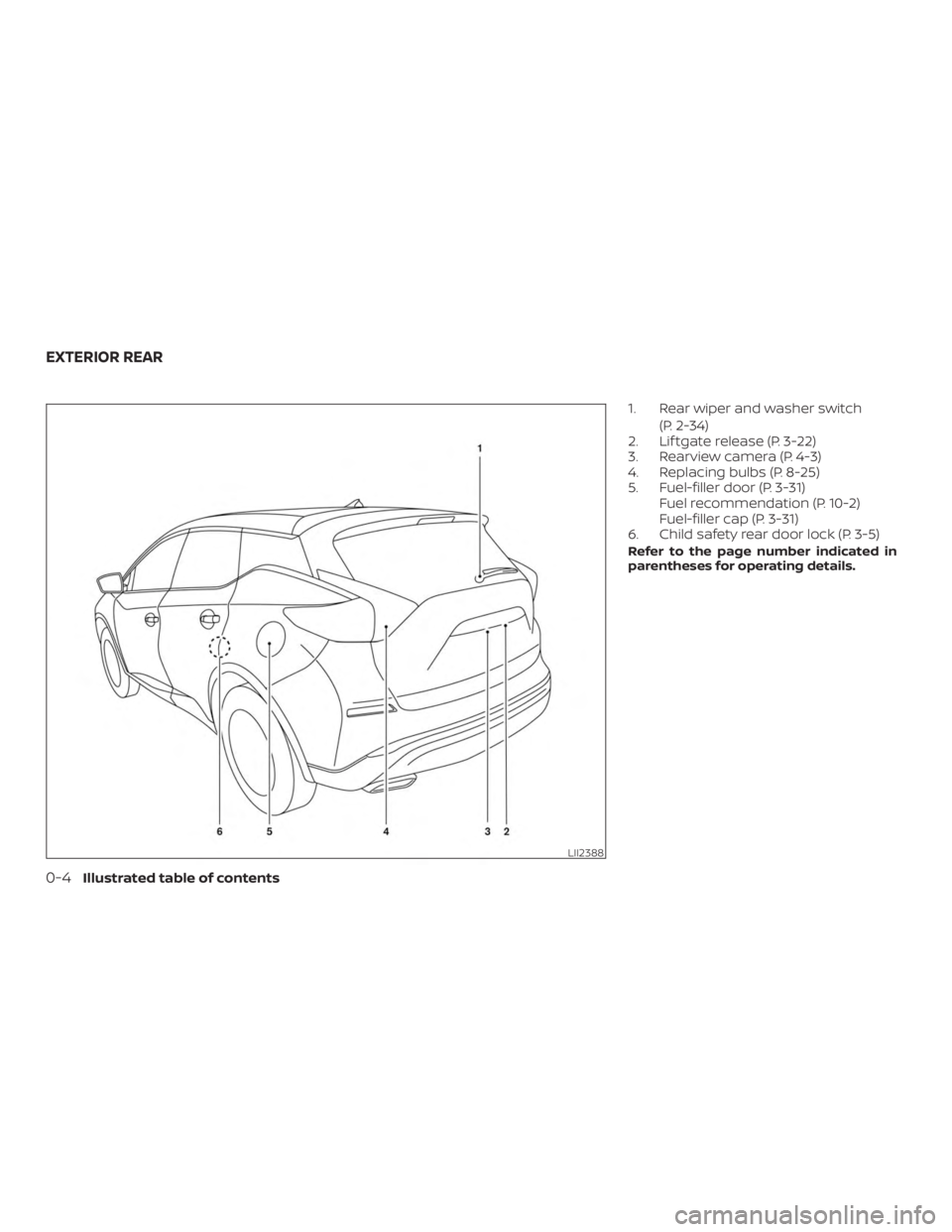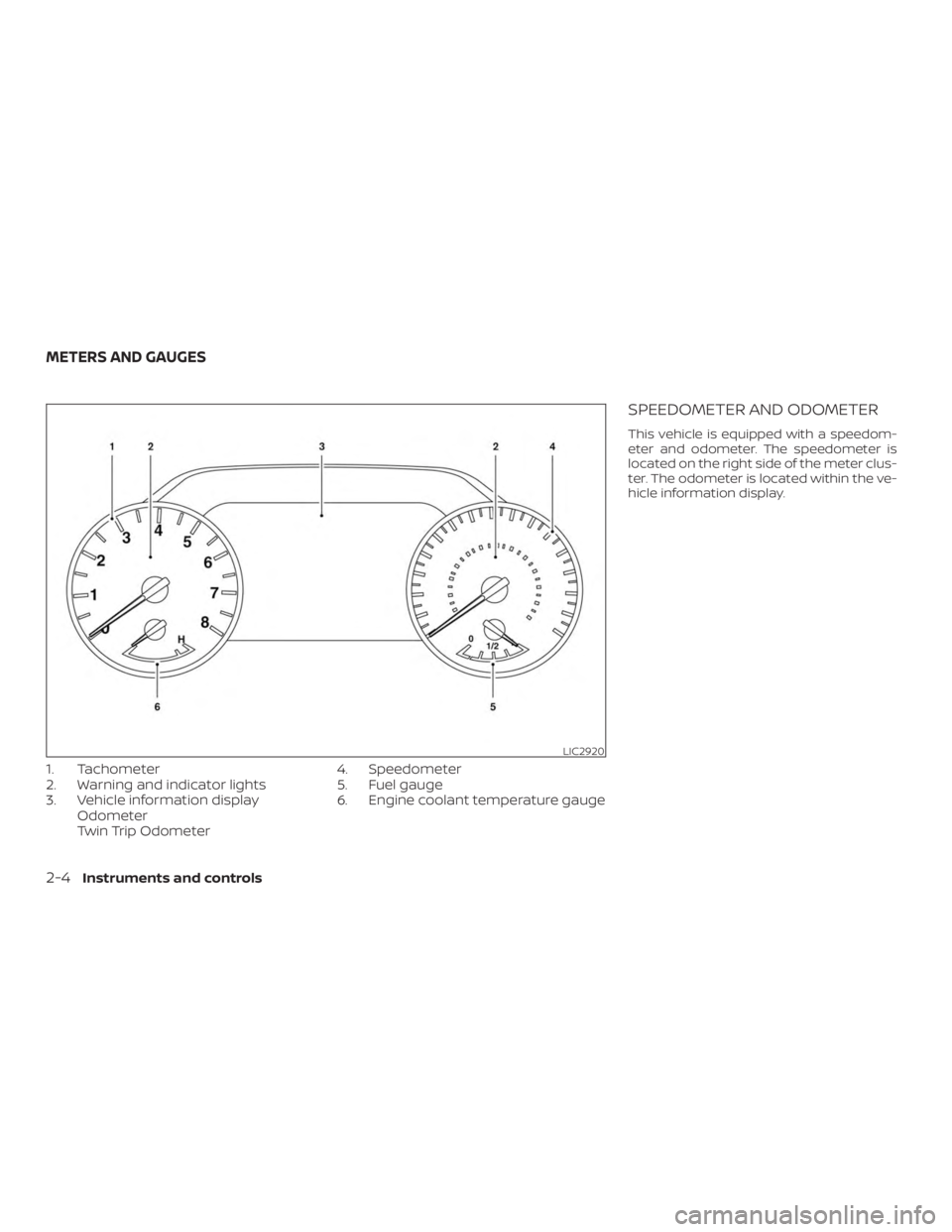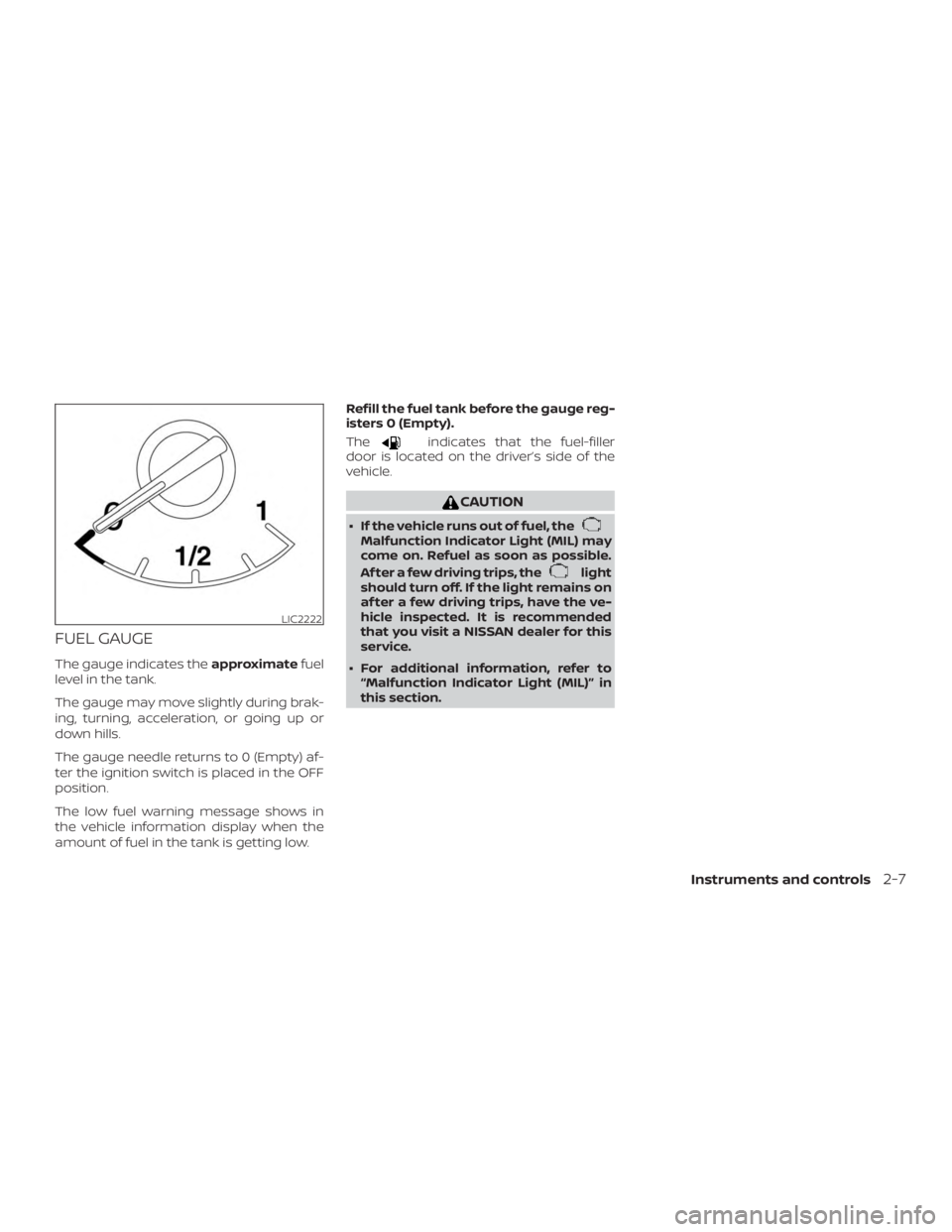2018 NISSAN MURANO fuel
[x] Cancel search: fuelPage 14 of 460

1. Rear wiper and washer switch(P. 2-34)
2. Lif tgate release (P. 3-22)
3. Rearview camera (P. 4-3)
4. Replacing bulbs (P. 8-25)
5. Fuel-filler door (P. 3-31) Fuel recommendation (P. 10-2)
Fuel-filler cap (P. 3-31)
6. Child safety rear door lock (P. 3-5)
Refer to the page number indicated in
parentheses for operating details.
LII2388
EXTERIOR REAR
0-4Illustrated table of contents
Page 17 of 460

16. Push-button ignition switch(P. 5-13)
17. Cruise control switches
(if so equipped) (P. 5-43)
Intelligent Cruise Control (ICC)
switches (if so equipped) (P. 5-44)
18. Driver supplemental knee air bag
(P. 1-49)
19. Bluetooth® Hands-Free Phone
System/Audio control switches
(P. 4-2)
20. Hood release (P. 3-22) Fuel door release (P. 3-31)
Powered rear seatback switch
(P. 1-2)
21. Fuse box (P. 8-20)
22. Power lif tgate main switch
(if so equipped) (P. 3-22)
Heated steering wheel switch
(if so equipped) (P. 2-45)
Vehicle Dynamic Control (VDC) OFF
switch (P. 2-46)
23. Instrument brightness control
(P. 2-37)
Twin trip odometer reset switch
(P. 2-4)*: Refer to the separate NissanConnect®
Owner’s Manual.
Refer to the page number indicated in
parentheses for operating details.
Illustrated table of contents0-7
Page 92 of 460

2 Instruments and controls
Instrument panel................................2-2
Meters and gauges ..............................2-4
Speedometer and odometer .................2-4
Tachometer ..................................2-6
Engine coolant temperature gauge ..........2-6
Fuel gauge ................................... 2-7
Warning lights, indicator lights and audible
reminders .......................................2-8
Checking lights ...............................2-8
Warning lights ................................2-9
Indicator lights .............................. 2-13
Audible reminders ........................... 2-16
Vehicle information display .....................2-16
How to use the vehicle information
display ...................................... 2-17
Startup display .............................. 2-18
Settings ..................................... 2-18
Vehicle information display warnings
and indicators ............................... 2-27
Security systems ............................... 2-31
Vehicle security system .....................2-31
NISSAN Vehicle Immobilizer System .........2-32
Wiper and washer switch .......................2-34
Switch operation ............................ 2-34Rear switch operation
.......................2-35
Rear window and outside mirror
(if so equipped) defroster switch ................2-36
Headlight and turn signal switch ...............2-37
Headlight control switch .....................2-37
Daytime Running Lights (DRL) system
(Type A) (if so equipped) .....................2-39
LED Daytime Running Lights (DRL)
system (Type B) (if so equipped) .............2-39
Instrument brightness control ...............2-40
Turn signal switch ........................... 2-40
Fog light switch (if so equipped) .............2-41
Horn ........................................... 2-41
Climate controlled seat switches
(if so equipped) ................................. 2-42
Heated seat switches (if so equipped) ..........2-43
Heated rear seat switches (if so equipped) ......2-44
Heated steering wheel switch (if so equipped) . . 2-45
Vehicle Dynamic Control (VDC) OFF switch ......2-46
E-c
all (SOS) switch (if so equipped) ..............2-47
Power outlets ..................................2-47
12v outlets ...................................2-47
Extended storage switch .......................2-48
Storage ........................................ 2-49
Page 95 of 460

16. Push-button ignition switch(P. 5-13)
17. Cruise control switches
(if so equipped) (P. 5-43)
Intelligent Cruise Control (ICC)
switches (if so equipped) (P. 5-44)
18. Driver supplemental knee air bag
(P. 1-49)
19. Bluetooth® Hands-Free Phone
System/Audio control switches
(P. 4-2)
20. Hood release (P. 3-22) Fuel door release (P. 3-31)
Powered rear seatback switch
(P. 1-2)
21. Fuse box (P. 8-20)
22. Power lif tgate main switch
(if so equipped) (P. 3-22)
Heated steering wheel switch
(if so equipped) (P. 2-45)
Vehicle Dynamic Control (VDC) OFF
switch (P. 2-46)
23. Instrument brightness control
(P. 2-37)
Twin trip odometer reset switch
(P. 2-4)*: Refer to the separate NissanConnect®
Owner’s Manual.
Refer to the page number indicated in
parentheses for operating details.
Instruments and controls2-3
Page 96 of 460

1. Tachometer
2. Warning and indicator lights
3. Vehicle information displayOdometer
Twin Trip Odometer 4. Speedometer
5. Fuel gauge
6. Engine coolant temperature gauge
SPEEDOMETER AND ODOMETER
This vehicle is equipped with a speedom-
eter and odometer. The speedometer is
located on the right side of the meter clus-
ter. The odometer is located within the ve-
hicle information display.
LIC2920
METERS AND GAUGES
2-4Instruments and controls
Page 99 of 460

FUEL GAUGE
The gauge indicates theapproximatefuel
level in the tank.
The gauge may move slightly during brak-
ing, turning, acceleration, or going up or
down hills.
The gauge needle returns to 0 (Empty) af-
ter the ignition switch is placed in the OFF
position.
The low fuel warning message shows in
the vehicle information display when the
amount of fuel in the tank is getting low. Refill the fuel tank before the gauge reg-
isters 0 (Empty).
The
indicates that the fuel-filler
door is located on the driver’s side of the
vehicle.
CAUTION
∙ If the vehicle runs out of fuel, theMalfunction Indicator Light (MIL) may
come on. Refuel as soon as possible.
Af ter a few driving trips, the
light
should turn off. If the light remains on
af ter a few driving trips, have the ve-
hicle inspected. It is recommended
that you visit a NISSAN dealer for this
service.
∙ For additional information, refer to “Malfunction Indicator Light (MIL)” in
this section.
LIC2222
Instruments and controls2-7
Page 104 of 460

∙ When replacing a wheel without theTPMS such as the spare tire, the TPMS
will not function and the low tire pres-
sure warning light will flash for ap-
proximately 1 minute. The light will re-
main on af ter 1 minute. Have your
tires replaced and/or TPMS system
reset as soon as possible. It is recom-
mended that you visit a NISSAN dealer
for these services.
∙ Replacing tires with those not origi- nally specified by NISSAN could affect
the proper operation of the TPMS.
CAUTION
∙ The TPMS is not a substitute for theregular tire pressure check. Be sure to
check the tire pressure regularly.
∙ If the vehicle is being driven at speeds of less than 16 mph (25 km/h), the
TPMS may not operate correctly.
∙ Be sure to install the specified size of tires to the four wheels correctly.
Master warning light
When the ignition switch is in the ON posi-
tion, the master warning light illuminates if
any of the following are displayed on the
vehicle information display:
∙ No key warning
∙ Low fuel warning
∙ Low washer fluid warning
∙ Parking brake release warning
∙ Door open warning
∙ Loose fuel cap warning (if so equipped)
∙ Check tire pressure warning
For additional information, refer to “Vehicle
information display” in this section.
Power steering warning light
WARNING
∙ If the engine is not running or is turned off while driving, the power as-
sist for the steering will not work.
Steering will be harder to operate. ∙ When the power steering warning
light illuminates with the engine run-
ning, there will be no power assist for
the steering. You will still have control
of the vehicle, but the steering will be
harder to operate. Have the power
steering system checked. It is recom-
mended that you visit a NISSAN dealer
for this service.
When the ignition switch is placed in the ON
position, the power steering warning light
illuminates. Af ter starting the engine, the
power steering warning light turns off. This
indicates the power steering is operational.
If the power steering warning light illumi-
nates while the engine is running, it may
indicate the power steering is not function-
ing properly and may need servicing. Have
the power steering checked. It is recom-
mended that you visit a NISSAN dealer for
this service.
When the power steering warning light illu-
minates with the engine running, there will
be no power assist for the steering, but you
will still have control of the vehicle. At this
time, greater steering effort is required to
operate the steering wheel, especially in
sharp turns and at low speeds.
2-12Instruments and controls
Page 106 of 460

Front passenger air bagstatus light
The front passenger air bag status light will
be lit and the passenger front air bag will be
OFF depending on how the front passen-
ger seat is being used.
For additional information, refer to “Front
passenger air bag and status light” in the
“Safety — Seats, seat belts and supplemen-
tal restraint system” section of this manual.
High beam indicator light(blue)
This blue light comes on when the head-
light high beams are on and goes out when
the low beams are selected.
The high beam indicator light also comes
on when the passing signal is activated.
Malfunction Indicator Light(MIL)
If this indicator light comes on steady or
blinks while the engine is running, it may
indicate a potential emission control mal-
function. The MIL may also come on steady if the
fuel-filler cap is loose or missing, or if the
vehicle runs out of fuel. Check to make sure
the fuel-filler cap is installed and closed
tightly, and that the vehicle has at least
3 gallons (11.4 liters) of fuel in the fuel tank.
Af ter a few driving trips, the
light
should turn off if no other potential emis-
sion control system malfunction exists.
If this indicator light comes on steady for
20 seconds and then blinks for 10 seconds
when the engine is not running, it indicates
that the vehicle is not ready for an emission
control system inspection/maintenance
test. For additional information, refer to
“Readiness for Inspection/Maintenance
(I/M) test” in the “Technical and consumer
information” section of this manual. Operation
The MIL will come on in one of two ways:
∙
MIL on steady — An emission control sys-
tem malfunction has been detected.
Check the fuel-filler cap if the Loose Fuel
Cap warning appears in the vehicle infor-
mation display. If the fuel-filler cap is
loose or missing, tighten or install the cap
and continue to drive the vehicle.
The
light should turn off af ter a few
driving trips. If the
light does not
turn off af ter a few driving trips, have the
vehicle inspected. It is recommended
that you visit a NISSAN dealer for this ser-
vice. You do not need to have your vehicle
towed to the dealer.
∙MIL blinking — An engine misfire has been
detected which may damage the emis-
sion control system. To reduce or avoid
emission control system damage:
– do not drive at speeds above 45 mph (72 km/h).
– avoid hard acceleration or decelera- tion.
– avoid steep uphill grades.
– if possible, reduce the amount of cargo being hauled or towed.
2-14Instruments and controls